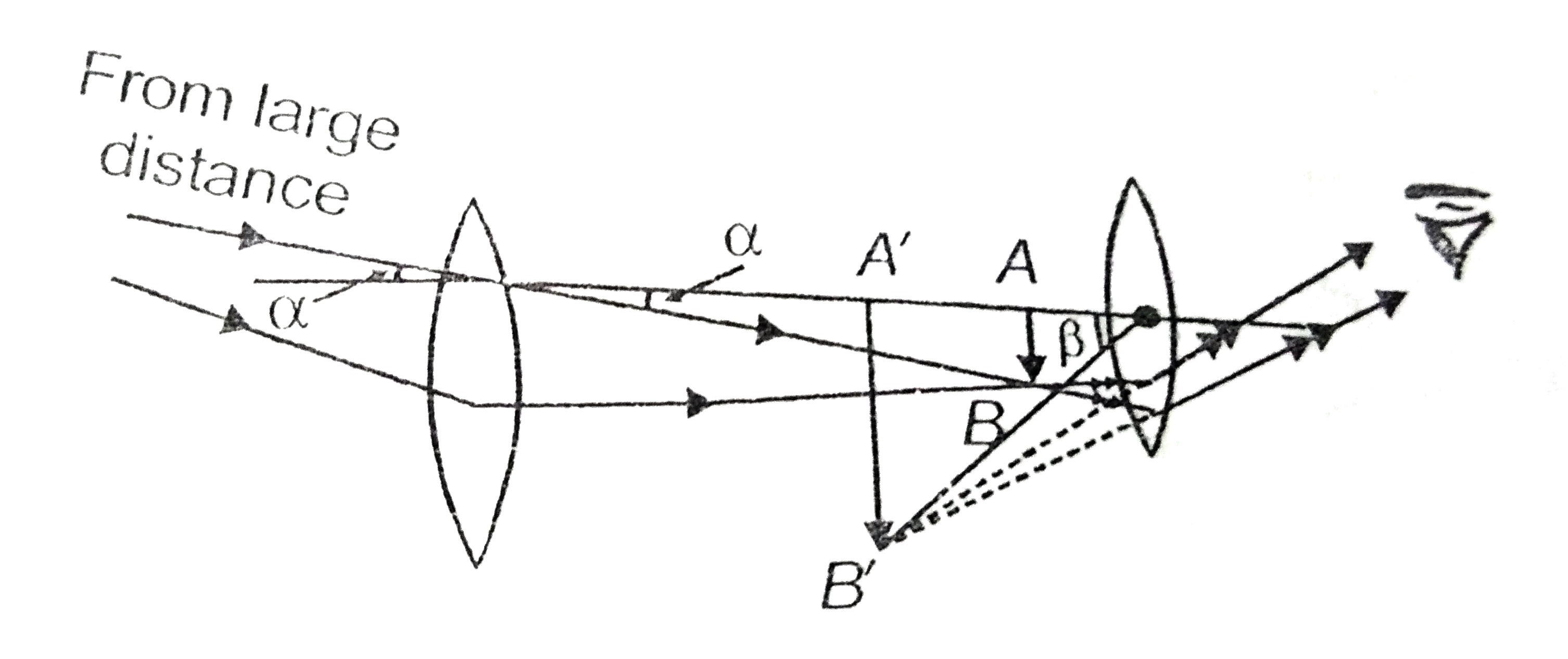The figure shows a simple arrangement which works as an astronomical telescope. The arrangement consists of two convex lenses placed coaxially. The lens which faces a distant object is called the objective. It has a large aperture and a large focal length also. The second lens is closed to the observers eyes. It is called the eyepiece. It has a smaller aperture as compared to the objective. Its focal length is also small in comparison to objective.

The objective forms a real image of a distant object. This image acts as the object for the eyepiece. The eye-piece may form its image at a large distance (∞) or at least distance of distinct vision (D = 25 cm). The magnifying power of the telescope is the ratio −βα. Maximum angular magnification is produced when the final image is at the least distance of distinct vision.
A telescope has an objective of focal length 50 cm and an eye-piece of focal length 5 cm. The least distance of distinct vision is 25 cm. The telescope is adjusted for distinct vision and it is focussed on an object 200 cm away. The length of the telescope is
L=f0+fe
L<f0+fe
L>f0+fe
L=f0−fe
The correct Answer is:B
Step by step video solution for The figure shows a simple arrangement which works as an astronomical telescope. The arrangement consists of two convex lenses placed coaxially. The lens which faces a distant object is called the objective. It has a large aperture and a large focal length also. The second lens is closed to the observers eyes. It is called the eyepiece. It has a smaller aperture as compared to the objective. Its focal length is also small in comparison to objective. The objective forms a real image of a distant object. This image acts as the object for the eyepiece. The eye-piece may form its image at a large distance (oo) or at least distance of distinct vision (D = 25 cm). The magnifying power of the telescope is the ratio (-beta)/(alpha). Maximum angular magnification is produced when the final image is at the least distance of distinct vision. A telescope has an objective of focal length 50 cm and an eye-piece of focal length 5 cm. The least distance of distinct vision is 25 cm. The telescope is adjusted for distinct vision and it is focussed on an object 200 cm away. The length of the telescope is by Physics experts to help you in doubts & scoring excellent marks in Class 12 exams.
Updated on:21/07/2023Topper's Solved these Questions
- RAY OPTICS AND OPTICAL INSTRUMENTSBOOK - AAKASH INSTITUTE ENGLISHCHAPTER - RAY OPTICS AND OPTICAL INSTRUMENTSEXERCISE - Assignment (Section - E) Assertion - Reason Type Questions
11 Videos
- RAY OPTICS AND OPTICAL INSTRUMENTSBOOK - AAKASH INSTITUTE ENGLISHCHAPTER - RAY OPTICS AND OPTICAL INSTRUMENTSEXERCISE - Assignment (Section - F) Matrix-Match Type Questions
4 Videos
- RAY OPTICS AND OPTICAL INSTRUMENTSBOOK - AAKASH INSTITUTE ENGLISHCHAPTER - RAY OPTICS AND OPTICAL INSTRUMENTSEXERCISE - Assignment (Section - C) Objective Type Questions (More than one option are correct)
9 Videos
- PHYSICAL WORLDBOOK - AAKASH INSTITUTE ENGLISHCHAPTER - PHYSICAL WORLDEXERCISE - ASSIGNMENT (Section-B)
4 Videos
- SEMICONDUCTOR ELECTRONICS (MATERIAL, DEVICES AND SIMPLE CIRUITS )BOOK - AAKASH INSTITUTE ENGLISHCHAPTER - SEMICONDUCTOR ELECTRONICS (MATERIAL, DEVICES AND SIMPLE CIRUITS )EXERCISE - Assignment SECTION - D (Assertion & reason type Question)
10 Videos
Similar Questions
An astronomical refractive telescope has an objective of focal length 20m and an eyepiece of focal length 2cm.Then the magnification
View SolutionA telescope has an objective of focal length 100 cm and an eye-piece of focal length 5 cm. What is the magnifying power of the telescope when it is in normal adjustment?
View Solution
Knowledge Check
An astronomical refractive telescope has an objective of focal length 20 m and an eyepiece of focal length 2 cm. Then
Athe magnification is 1000Bthe length of the telescope tube is 20.02 mCthe image formed is invertedDall of these.A small telescope has an objective lens of focal length 144cm and an eye-piece of focal length 6.0cm. What is the magnifying power of the telescope ? What is the separation between the objective and the eye-piece ?
A0.75cmB1.38cmC1.0mD1.5m
A planet is observed by an astronomical refracting telescope having an objective of ofcal length 16m and an eyepiece of focal length 2 cm. Then,
View SolutionA small telescope has an objective lens of focal length 150 cm and an eye piece of focal length 6.0 cm. The magnifying power of the telescope for distinct vision adjustment is:
View SolutionA small telescope has an objective lens of focal length 150 cm and an eye piece of focal length 6.0 cm. The magnifying power of the telescope for distinct vision adjustment is:
View SolutionThe length of a telescope, for which it is known that it has an objective lens of focal length 144 cm and an eye piece of focal length 6 cm is
View SolutionAn astronomical telescope has an objective of focal length 100 cm and an eye piece of focal length 5 cm. The final image of a star is seen 25 cm from the eyepiece. The magnifying power of the telescope is
View SolutionA small telescope has an objective lens of focal length 144cm and an eye-piece of focal length 6.0cm. What is the magnifying power of the telescope ? What is the separation between the objective and the eye-piece ?
View Solution
